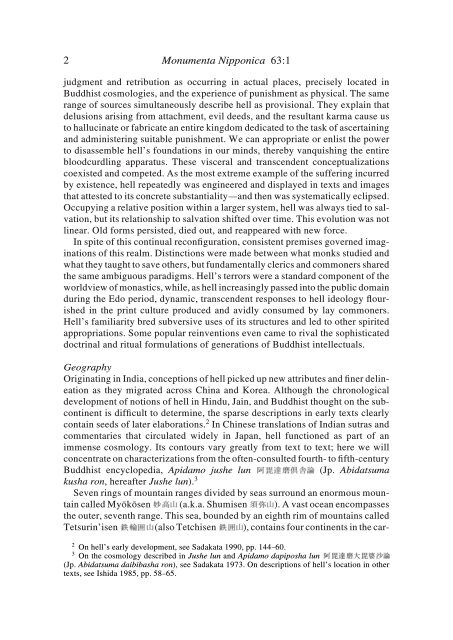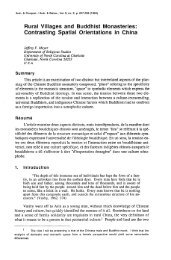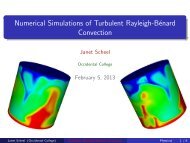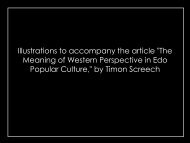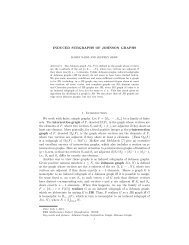A Primer on Japanese Hell Imagery and Imagination - Occidental ...
A Primer on Japanese Hell Imagery and Imagination - Occidental ...
A Primer on Japanese Hell Imagery and Imagination - Occidental ...
You also want an ePaper? Increase the reach of your titles
YUMPU automatically turns print PDFs into web optimized ePapers that Google loves.
2<br />
M<strong>on</strong>umenta Nipp<strong>on</strong>ica 63:1<br />
judgment <strong>and</strong> retributi<strong>on</strong> as occurring in actual places, precisely located in<br />
Buddhist cosmologies, <strong>and</strong> the experience of punishment as physical. The same<br />
range of sources simultaneously describe hell as provisi<strong>on</strong>al. They explain that<br />
delusi<strong>on</strong>s arising from attachment, evil deeds, <strong>and</strong> the resultant karma cause us<br />
to hallucinate or fabricate an entire kingdom dedicated to the task of ascertaining<br />
<strong>and</strong> administering suitable punishment. We can appropriate or enlist the power<br />
to disassemble hell’s foundati<strong>on</strong>s in our minds, thereby vanquishing the entire<br />
bloodcurdling apparatus. These visceral <strong>and</strong> transcendent c<strong>on</strong>ceptualizati<strong>on</strong>s<br />
coexisted <strong>and</strong> competed. As the most extreme example of the suffering incurred<br />
by existence, hell repeatedly was engineered <strong>and</strong> displayed in texts <strong>and</strong> images<br />
that attested to its c<strong>on</strong>crete substantiality—<strong>and</strong> then was systematically eclipsed.<br />
Occupying a relative positi<strong>on</strong> within a larger system, hell was always tied to salvati<strong>on</strong>,<br />
but its relati<strong>on</strong>ship to salvati<strong>on</strong> shifted over time. This evoluti<strong>on</strong> was not<br />
linear. Old forms persisted, died out, <strong>and</strong> reappeared with new force.<br />
In spite of this c<strong>on</strong>tinual rec<strong>on</strong>figurati<strong>on</strong>, c<strong>on</strong>sistent premises governed imaginati<strong>on</strong>s<br />
of this realm. Distincti<strong>on</strong>s were made between what m<strong>on</strong>ks studied <strong>and</strong><br />
what they taught to save others, but fundamentally clerics <strong>and</strong> comm<strong>on</strong>ers shared<br />
the same ambiguous paradigms. <strong>Hell</strong>’s terrors were a st<strong>and</strong>ard comp<strong>on</strong>ent of the<br />
worldview of m<strong>on</strong>astics, while, as hell increasingly passed into the public domain<br />
during the Edo period, dynamic, transcendent resp<strong>on</strong>ses to hell ideology flourished<br />
in the print culture produced <strong>and</strong> avidly c<strong>on</strong>sumed by lay comm<strong>on</strong>ers.<br />
<strong>Hell</strong>’s familiarity bred subversive uses of its structures <strong>and</strong> led to other spirited<br />
appropriati<strong>on</strong>s. Some popular reinventi<strong>on</strong>s even came to rival the sophisticated<br />
doctrinal <strong>and</strong> ritual formulati<strong>on</strong>s of generati<strong>on</strong>s of Buddhist intellectuals.<br />
Geography<br />
Originating in India, c<strong>on</strong>cepti<strong>on</strong>s of hell picked up new attributes <strong>and</strong> finer delineati<strong>on</strong><br />
as they migrated across China <strong>and</strong> Korea. Although the chr<strong>on</strong>ological<br />
development of noti<strong>on</strong>s of hell in Hindu, Jain, <strong>and</strong> Buddhist thought <strong>on</strong> the subc<strong>on</strong>tinent<br />
is difficult to determine, the sparse descripti<strong>on</strong>s in early texts clearly<br />
c<strong>on</strong>tain seeds of later elaborati<strong>on</strong>s. 2 In Chinese translati<strong>on</strong>s of Indian sutras <strong>and</strong><br />
commentaries that circulated widely in Japan, hell functi<strong>on</strong>ed as part of an<br />
immense cosmology. Its c<strong>on</strong>tours vary greatly from text to text; here we will<br />
c<strong>on</strong>centrate <strong>on</strong> characterizati<strong>on</strong>s from the often-c<strong>on</strong>sulted fourth- to fifth-century<br />
Buddhist encyclopedia, Apidamo jushe lun<br />
(Jp. Abidatsuma<br />
kusha r<strong>on</strong>, hereafter Jushe lun). 3<br />
Seven rings of mountain ranges divided by seas surround an enormous mountain<br />
called Myôkôsen (a.k.a. Shumisen ). A vast ocean encompasses<br />
the outer, seventh range. This sea, bounded by an eighth rim of mountains called<br />
Tetsurin’isen (also Tetchisen ), c<strong>on</strong>tains four c<strong>on</strong>tinents in the car-<br />
2 On hell’s early development, see Sadakata 1990, pp. 144–60.<br />
3 On the cosmology described in Jushe lun <strong>and</strong> Apidamo dapiposha lun<br />
(Jp. Abidatsuma daibibasha r<strong>on</strong>), see Sadakata 1973. On descripti<strong>on</strong>s of hell’s locati<strong>on</strong> in other<br />
texts, see Ishida 1985, pp. 58–65.


